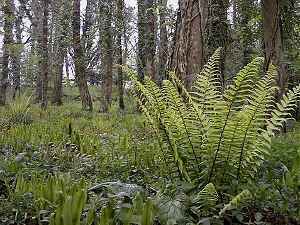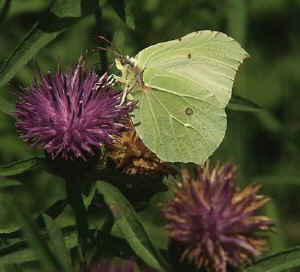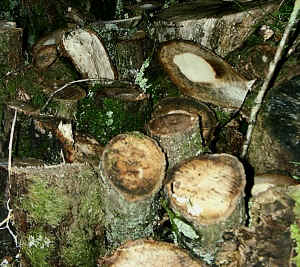Managing Woodlands for
Biodiversity (5)
previous
 |
Woodlands have quite different
microclimates to areas which are more open. They will generally have a higher humidity,
cooler temperatures, with smaller fluctuations, as well as lower wind speeds. Maintenance
of these conditions is important for the survival of many woodland species. For example,
many species of lichens, mosses, liverworts and ferns (left) are unable to survive
more exposed open conditions. To maintain sheltered areas within a woodland, tree felling should where possible, be restricted to small blocks. In this way large areas are not cleared of trees (and hence shelter) all at once. Woodland operations should avoid disturbing specific nesting and breeding sites. |
| . | |
 |
Climbers such as Ivy, Honeysuckle and Clematis (Clematis
vitalba, not garden varieties of Clematis) provide valuable food and cover for
invertebrates, birds and mammals within a woodland. Brimstone butterflies (left) will often
overwinter by sheltering inside dense growths of ivy. Honeysuckle and Clematis climb by twining, which can occasionally damage young trees. These climbers may have to be controlled in young plantations, but once the canopy has closed over, this should be unnecessary. Ivy produces masses of adventitious roots which adhere to the underlying substrate, rather than climbing by twining. Extensive Ivy growths on trees exposed to high winds may act as a 'sail' making the tree more likely to be toppled. It may need to be cut back on such trees, but otherwise, as with Honeysuckle and Clematis, it should be left to benefit wildlife. |
| . | |
 |
Microhabitats such as piles of logs provide vital shelter for a great variety of woodland creatures from newts and toads, to woodlice and millipedes. Leaving cut timber in a variety of different areas will greatly enhance biodiversity by providing shelter and a damp microclimate. It will also provide a variety of microhabitats for the many different species which inhabit rotting wood in Britain. |
Woodland Management Contents